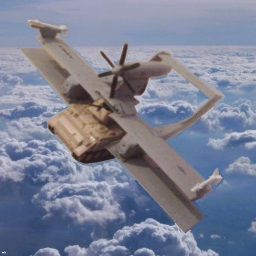
You would have to cut the fiber or hope the pulsed laser melts it.
90% of the physics aside, this theory is like saying that crossing flashlight beams would cause interference. This is also ignoring the density difference between the fiber and the air.
All things considered, I think we are looking at the new Russian wunderwaffe. Coming to a T-14 near you.
i worked with fibers before and its 100% possible to inject enough light into a fiber to cause errors at the Rx without melting the fiber, flash lights are not coherent light and are not focused enough for that (also not pulsed)
Into raw unshielded fibers tho probably, right?
That’s what they’re using for the drones, tho.
Oh i see lol
why tho? a little bit of paint won’t be too much weight, right?
Im no expert here, but these drones have to fly many kilometers and they carry the spool on board, so the added weight is probably an issue. I assume the production would be much more complicated too. For normal industrial underground fibers the shielding can be quite thick and stiff, but for this you would need some kinda coating that can be incredibly thin while also somehow blocking all light.

Vapor deposited metal film. Expensive, but I wouldn’t be surprised if they already use exactly that to handle interference from the sun. Even non-coherent light can wash the sensors out if you have enough of it.
Hmm. I’d guess that filtering all frequencies outside the data transmission window could help there, but I don’t really know.
These are supposed to be disposable, and are hastily being put together in wartime conditions by largely non-Western countries. Exotic solutions are highly disfavored.
The space shuttle launch fuel tank was only painted for the first two launches. They stopped because the paint weighed 600 pounds and didnt offer any real benefit. So yeah, a little bit of paint does add up.
Also, you have to consider that a single fiber has pretty high surface-volume ratio.
With no computer error correction.
I thought that was only really an issue if the fiber was damaged in any way. (It would create a point where the external light could refract into the core) Then again, there isn’t going to be a sheath on that cable and its not exactly a sterile environment.
Meh, I’m an idiot and that’s OK!
As long as the angle of attack is between 90°-45° between 0->50->0 % of the external light will enter. No matter your angle of attack, half of the light at least is always going to be reflected. The angle of total internal reflection is 45°, so as long as you are greater than that there wont be “total external reflection” aka no light can enter. The issue is that(barring the refraction of the light as it passes through the air/fiber medium) the angle of attack once in the fiber is still maintained, meaning it does not achieve total internal reflection and therefore passes through the cable without interfering at all(in the case of a atraight cable.
In practice, no cable is going to be perfectly straight, and i would imagine the air/fiber medium may bend certain angles enough to where they can enter above the needed angle of attack, but once inside are bent to be under the needed angle of attack. Both of those imperfections would allow this type of attack to work. In reality all you would need to fix this is to use rolling polarities with very minor error correction. On board the drone give it a 10$ thermal infared lens and a basic processor. Tell it if the cable either cannot be read or is missing while the drone is in flight, it targets the last heat signature it saw.
ok so polarize the light in the fiber, gg no interference
Interesting, good to know! I would have thought they’d be pretty good at not scattering anything.
Fluorescence is a thing.
The problem here (despite using a giant laser on the least effective way possible) is that any kind of error correction can deal with your pulsing interference, and you are letting the drone get a bit too close.
But by harnessing disco ball technology, we can make this a multidirectional field defense.
… and its just overpowered spaceheaters with concave reflector/concentrators, made of hand polished titanium for some reason, that have to be manually aimed.
Hope you can handle the legal fees for breach of patent law, OP.
…
Boeing Plasma Forcefield has entered the chat
…
Hey yo, sup.

Yeah looks to me like you’re using just a tiny fraction, just a specialized version of what we patented over a decade ago, nothing novel, nothing distinct, just a specific operating mode of our tech.
We can serve you with the lawsuit now, or we can call in a welfare check on your lifeless body within 72 hrs, your choice.
Umm, one death please! Oh, no. No no no, I meant cake. Please give me cake!
ominous whirring sound that begins to climb in pitch and volume to a modulated crackle
Well we’re out of cake, we didn’t expect such a rush!
Why not just put a really big spool of weedwhacker wire on a really fast motor on top of the tank and cut the drone down?
-
Cuts fibre/messes with fibre.
-
Drone goes straight forward into the tank.
-
???
-
BOUM. Profit.
-
how hard would it be to make a radioactive beam. which roll fry any and all electronics in its path,
which will be used in war as a “counterdrone”. but used on people would be a serious war crime… which will become common and ignored.
You got me considering an unshielded, focused/directed microwave beam. And then my dumbass realized I had reinvented the MASER (Microwave Amplification by Stimulated Emission of Radiation).
So, why aren’t defenders using those?
Its generally always the same problem with any kind of laser, maser, whatever variant of a beam of intense energy of some frequency:
They require stupendous amounts of energy, and if your platform is mobile, that means batteries.
Batteries that are big, heavy, and tend to immolate like a burning cybertruck at fucking 1800 F or what not if structurally comprimised.
We still have yet to get reliable, hardy, high energy dense batteries to a point where it doesn’t either massively weigh down your platform, or require some absurdly expensive production process for a more advanced battery, because we only know how to make ‘can test its properties in a lab’ volumes, not ‘actually industrial scale mass manufacturing’ levels.
They make kinda sense on say, a naval mounted rail gun… they do not downscale to truck, tank, infantry scale.
Like you could maybe make a giant rail gun tank with current tech. Maybe.
Problem is it would be ~70% battery by mass, weigh ~250 tons, be able to fire maybe… 5, 10 times? and if basically anything pens the armor, you now have an inferno that will burn for 12 to 24 hours, likely into a slag that actually burns or digs a hole a foot or two into the ground, roughly shaped like its foot print.
i think masers sort of suck. as when strong enough to be useful they create plasma and plasma scatters the maser.
although I read that quite a while back, so maybe progress has changed that
Beens months I’m saying a simple flame thrower should easily melt the wires.
Now let’s add a hat of flamethrower to tanks.Unironically you can shine a laser down the fibers and watch it light up all the way back to the source.
deleted by creator











